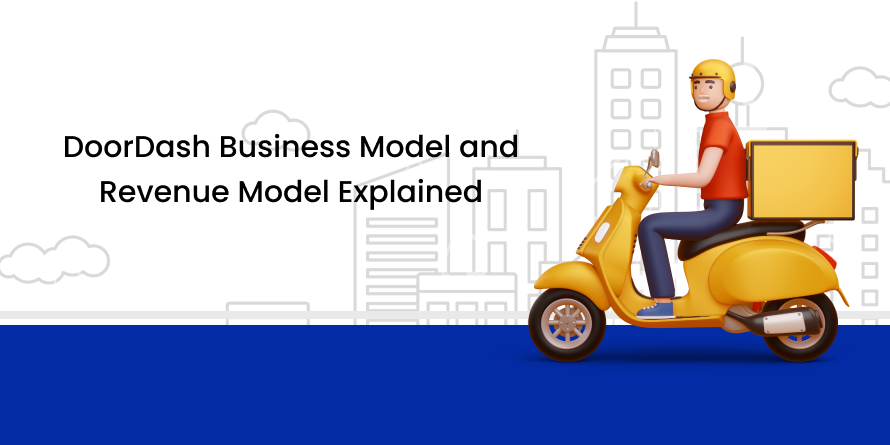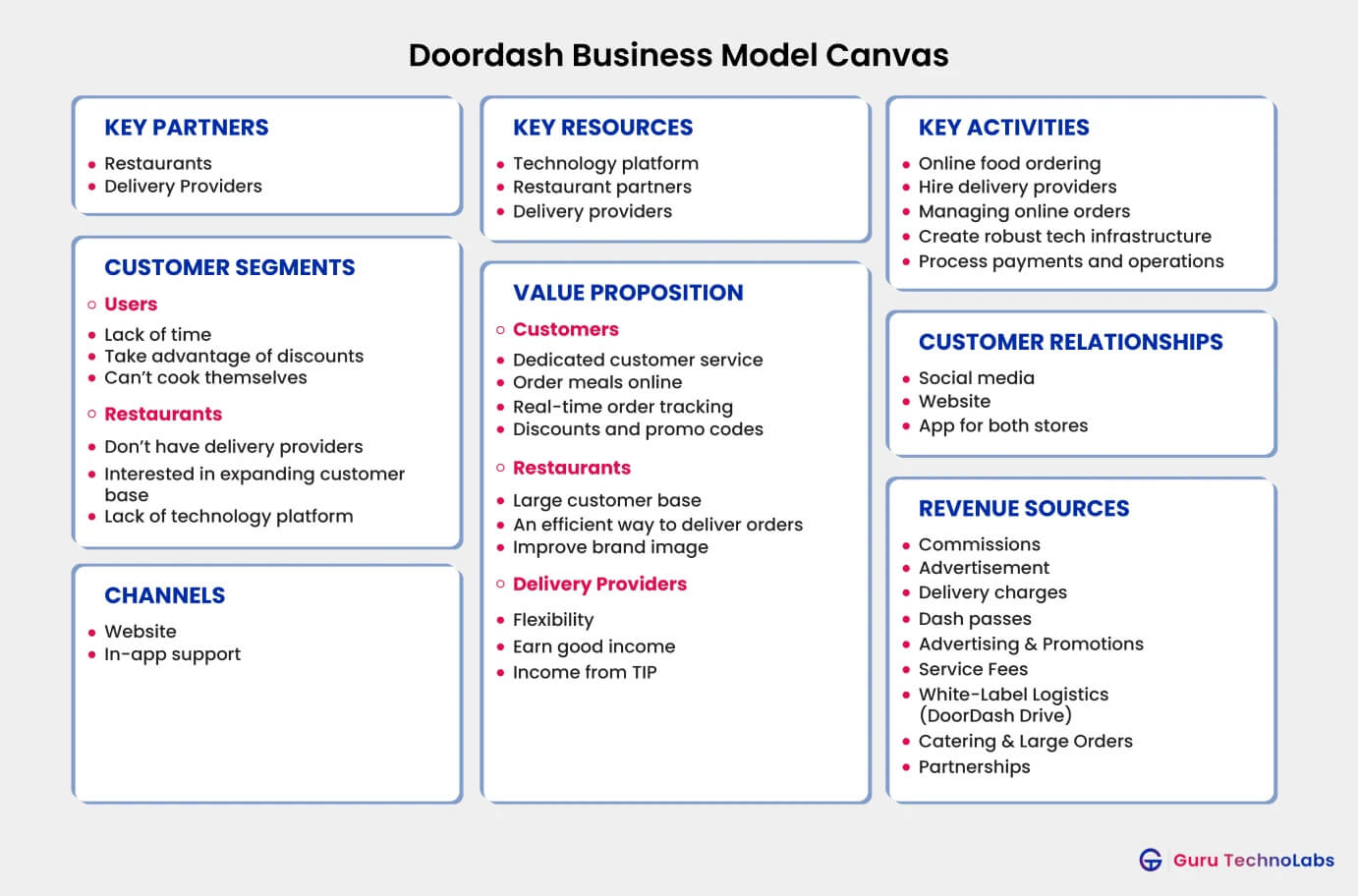DoorDash Business Model and Revenue Model Explained

Ordering food online these days is no longer obscure.
Ordering food online was once considered a luxury, as only big and popular restaurants offered this facility to specific customers. But now, getting food delivered to your doorstep is becoming more popular and pleasurable because of the development of “digital restaurants” like Doordash, Postmates, GrubHub, Talabat, Zomato, etc.
Now, modern technology solutions are making ordering food online more popular. Doordash is one of the players that has risen to the top in the USA food delivery market. It is a USA-original food delivery app that operates on demand. The app has simplified people’s lives by bringing many dishes and restaurants to customers’ front doors.
The statistics show that the revenue from the online food delivery market has surged by 204% in the last five years. This has attracted many budding entrepreneurs to explore Doordash’s business model. If you are one of those entrepreneurs, here’s a complete guide to help you learn how Doordash works and how it makes money.
Before we discuss Doordash’s business model, let’s examine its characteristics and some interesting facts and figures about it.
What is Doordash?
Doordash, a name synonymous with exploring delicious dishes, was founded in 2013. Established by Tony Xu, Stanley Tang, Evan Moore, and Andy Fang, the company initially started as PaloAltoDelivery.com before evolving into the Doordash we know today. Their mission? To simplify online food orders and delivery for users across the nation.
Doordash’s reach extends far beyond its USA origins. It now operates in more than six countries, including Australia, Canada, Germany, New Zealand, Japan, and 18 cities in the USA. This impressive expansion reflects its dedication and commitment to serving a global audience of food enthusiasts.
With an impressive 55% market share across the USA food delivery market, Doordash holds a top position and proudly boasts profitability across all regions.
Throughout its history, Doordash has faced many lawsuits and legal cases, mainly regarding drivers, known as “dashers,” but that didn’t stop the company from reaching the top spot in the USA food delivery market.
Interesting Facts About Doordash
Founded in 2013, Doordash is a popular USA-based food delivery app that allows customers to browse restaurants, order food, and deliver it to their doorsteps quickly. Doordash connects restaurants, delivery providers, and customers on a single platform.
Year of Founded: 2013
Founders: Andy Fang, Tony Xu, Evan Moore, and Stanley Tang
Headquarters: San Francisco, USA
Industry: Online food ordering
Area Served: Australia, Canada, Germany, New Zeland, USA, and Japan
Number of Funding Rounds: 12
Number of Acquisitions: 7
Number of Employees: 19,300
Website: doordash.com
- As of December 21, 2020, the platform was used by 450,000 merchants, more than 20,000,000 customers, and one million delivery partners.
- Doordash is a Y-Comninator-backed company.
- The company aims to “enhance life through innovative services” by offering customers various food options for on-demand deliveries from any city corner.
- Doordash charges delivery fees between $3 to $8 from customers.
- Moreover, the platform charges 20% commission from the restaurants.
- The company expanded its offerings amid the coronavirus pandemic and added grocery delivery in California and the Midwest in August 2020.
Breakdown of Doordash History and Timeline
Doordash Inc. is a renowned company that operates online food delivery. With a noticeable 60% market share in the convenience delivery category, Doordash has become the talk of the town across the USA and other regions.
1. 2012: Doordash was founded by Stanford University students.
2. 2013: They launched a platform called PaloAltoDelivery.com in Palo Alto, California. In the same year, the company received $120,000 in seed money from Y Combinator in exchange for a 7% stake.
3. 2018: The platform overtook UberEats in the US food delivery sales.
4. 2019: Doordash has never looked back. It also surpassed GrubHub and became the most significant food delivery operator in the USA.
5. 2019: Doordash opened its first ghost kitchen with four restaurants in the same year.
6. 2020: In June 2020, the company raised over $2.5 billion through several funding rounds from investors, including Combinators, Charles River Ventures, GIC, and Khosla Ventures.
7. 2020: Moreover, amid the pandemic, the company gave gloved and sanitizer bottles to delivery providers for free to prevent the virus spread.
8. 2021: Before the year ends, the company went public, launched its IPO, and raised $3.37 billion.
9. 2022: 55% of Doordash’s drivers were women.
10. 2023: The company moved its stock listing from the New York Stock Exchange to the Nasdaq in September.
Doordash’s profound journey from a small startup to a giant US food delivery industry player highlights its ability to adapt to evolving market needs and scale swiftly. With a strong foundation, the company has undoubtedly put many eggs in its basket regarding growth and profitability. Now, let’s discuss how Doordash works and connects all the stakeholders within one platform.
Want to Enter an On-demand App Development Landscape?
We create user-friendly, high-performing apps to match your business needs.
How Does Doordash Work?
Doordash has a simple food ordering process. By providing comprehensive restaurant information, including menus, costs, ratings, and images, It quickly became the go-to app for food enthusiasts.
1. Search and Explore: After downloading the app from the Play Store or App Store, users need to enable location and can search restaurants within their vicinity.
2. Browse Menus: Once users have found a restaurant, they can view menus, including pictures and the cost of the dish, check reviews, and much more.
3. Place an Order: Once users are done exploring the menu, they can add a dish to the cart, apply available discounts, and make payment from the options given.
4. Restaurant Receives the Order: Once the order is placed, the restaurant “accepts” it and prepares for it.
5. Delivery Provider Picksup the Order: Restaurants assign the order to nearby delivery providers; they pick it up and reach the customer’s location.
6. Final Delivery: The delivery provider reaches the location, hands over the order, and asks customers to rate and review the service based on the overall experience
The platform uses advanced algorithms to optimize delivery routes and reduce delivery time. The company also offers real-time tracking features to improve the customer experience.
Quick Side Note: While third-party food delivery apps have revolutionized the way we order food, as a restaurant owner, you may not want to pay hefty commissions on each order. Opting to develop a food delivery app can be a smart investment, allowing you to create a customized solution that caters to your business needs.
It not only helps you save on long-term commission fees but also allows you to build a stronger brand identity. With a tailored solution, you can offer a more personalized customer experience while retaining full control over your operations and profits.
Doordash Business Model: Learn Everything About Components Included

The primary goal of the Doordash is to make the food ordering and delivery process easier for customers and restaurants. It follows a simple business model that connects customers with restaurants and allows them to get food at their doorsteps.
Doordash’s Customer Segments
Doordash operates on a Y-structure business model. It focuses on all three segments of food delivery: users, restaurants, and delivery providers aka Dashers.
Users:
1. People who lead a busy life and don’t want to cook
2. Students with no access to a kitchen facility
3. Professionals and working people who can’t dine due to traffic and lack of time.
Restaurants:
1. Restaurants that lack delivery personnel
2. Cafes, small joints, and restaurants that operate with limited seating facility
3. Restaurants that are interested in a larger user base but lack a digital platform
Delivery Providers:
1. People who need gig jobs and make side income
2. People who need a job with flexible timings
Doordash’s Value Proposition
Doordash is one of the biggest food delivery apps in the USA and offers multiple benefits to all stakeholders involved. Have a look below at how it adds value to customers, restaurants, and dashers.
For Customers:
1. A wide selection of restaurants to choose from
2. Dedicated customer support
3. Live order tracking
4. Better costing structure
5. Multiple payment options
6. Regular promotions, discounts, and offers
For Restaurants:
1. Doordash has its delivery persons.
2. Doordash provides restaurants with a larger customer base
3. The platform provides restaurants a software and an app to manage their orders and deliveries efficiently.
For Delivery Providers:
1. An excellent source of income to achieve goals
2. Handsome tips from customers
3. Flexible working schedule
Key Partners of Doordash
Doordash follows a two-sided marketplace process, which is advantageous for all stakeholders using the platform. The key partners of Doordash include:
1. Restaurants
2. Delivery providers mean Dashers
It offers excellent value to its users and has the capabilities to grow business highly. It offers a compelling value proposition to all its key partners.
How Does Doordash Make Money? Check Out the Revenue Model
Now that you have learned about the business model of Doordash, let’s have a look at the monetization strategies it follows to bring money to the table. The main ways in which the founders of Doordash make money through their business model include:
Commission on Each Order
Customers can order food online, and to offer this service, Doordash gets a commission from the restaurant establishments which is around 20%.
Delivery Fees
Along with commission fees, Doordash charges customers a delivery fee for each order. The delivery charges depend on the location and amount of the order. If customers don’t want to pay delivery fees, they can also opt for “Dashpass” subscription service.
Dashpass
The Dashpass from Doordash comes as a subscription service offering its customers the chance to save on delivery charges and service fees. Dashpass holders also benefit from lower service fees, and they also have the right to cancel the service at any time.
Advertising & Promotions
Doordash makes extra money by providing advertising options for restaurant partners. These ads help restaurants stand out on the platform, which can lead to more orders. By using paid promotions, restaurants can reach specific groups of customers, making their meals more visible in search results or on the homepage.
Service Fees
Doordash charges a service fee on top of the delivery fee for orders. This service fee is a percentage of the total order price and can change based on things like where you are, the type of restaurant, or how big your order is. Customers pay these fees directly, and they help Doordash earn more money.
White-Label Logistics (DoorDash Drive)
DoorDash Drive helps businesses use DoorDash’s delivery system without having to manage their own delivery service. It’s great for non-food companies or large chains that rely on dependable delivery options.
Catering & Large Orders
For big catering orders or events, DoorDash has a special service to handle large food deliveries. Because these orders are larger and need more planning, there is usually a higher service fee.
Partnerships
DoorDash teams up with different brands, restaurant chains, and even other delivery services. These partnerships usually create win-win deals, like special delivery arrangements, joint marketing efforts, or adding services like grocery delivery and retail options.
Enter the $200Bn Food Delivery Market with Doordash Like Food Delivery App
The food delivery market is experiencing immense growth, with the sector expected to surpass $200 billion in future years. Popular food delivery apps such as Doordash, GrubHub, and Postamtes have revolutionized how we access food. With the increasing demand for comfort, there’s never been a better time to tap into this lucrative market.
Whether you’re an entrepreneur looking to launch your delivery platform or a restaurant aiming to expand your reach, the opportunity is ripe for innovation and success.
If you are ready to take a plunge and want to build a food delivery app, we can help. Our team specializes in developing a fully functional food delivery app with an emerging technology stack. Want to enter the billion-dollar club? Contact us today and turn your idea into a profitable venture.
Frequently Asked Questions
Doordash is an on-demand food delivery app that delivers food and everyday essential items. The company aims to provide utmost comfort to its customers by offering on-time deliveries of food and household items.
Yes. With Guru TechnoLabs’ expertise, you can enter the market with the best solution. From giving top-tier support to adding multiple features and using a modern tech stack, we can help you launch a food delivery app from scratch.
Doordash charges a commission percent out of each order. The amount of commission that they charge usually lies in the range of 15% to 20%.
DoorDash follows an on-demand delivery and logistics business model. It connects customers, restaurants, and delivery drivers (Dashers) through its app to make food delivery fast and convenient.
DoorDash makes money through commissions from restaurants, delivery fees from customers, and service or subscription fees like DashPass. It also earns from advertising and promotions that restaurants pay to appear higher in search results.
DoorDash’s model serves three groups:
- Customers who order food,
- Restaurants that get more online orders, and
- Dashers who earn money by delivering.
DoorDash acts as a middleman, connecting all three and ensuring everyone benefits.


















